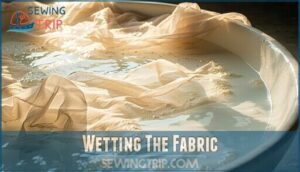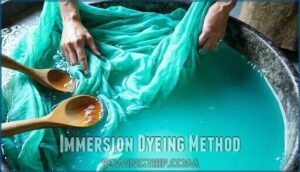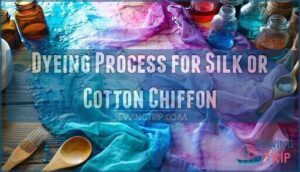This site is supported by our readers. We may earn a commission, at no cost to you, if you purchase through links.

Silk and cotton chiffon absorb dyes beautifully with fiber-reactive or acid dyes, while polyester chiffon demands synthetic dyes and higher heat—think of it as the difference between a sponge and plastic wrap.
Pre-wash your fabric, prepare dye according to package instructions, and use gentle immersion techniques to avoid damaging chiffon’s delicate weave.
Keep water temperature consistent and allow plenty of room for fabric movement.
The key? Patience and proper preparation turn this seemingly intimidating process into a rewarding transformation that’ll have you wondering why you waited so long to discover chiffon’s color potential.
Table Of Contents
- Key Takeaways
- Can Chiffon Be Dyed?
- Dyeing Chiffon: Tips and Considerations
- How to Prepare Chiffon for Dyeing
- Dye Application Techniques for Chiffon
- Rinse and Wash Process for Dyed Chiffon
- Drying and Clean Up After Dyeing Chiffon
- Dyeing Process for Silk or Cotton Chiffon
- Additional Tips for Dyeing Chiffon
- Interesting Facts About Chiffon
- How to Maintain and Take Care of Dyed Chiffon
- Frequently Asked Questions (FAQs)
- Conclusion
Key Takeaways
- Check your fabric composition first – Natural chiffon (silk/cotton) accepts dyes beautifully, while polyester chiffon requires specialized synthetic dyes and higher heat that can damage the delicate weave.
- Pre-wash and wet your chiffon thoroughly – Remove all stains and saturate the fabric completely before dyeing to ensure even color absorption and prevent splotchy results.
- Use gentle immersion techniques with constant agitation – Keep water temperature consistent (140-160°F), stir continuously with smooth motions, and give fabric plenty of room to move in the dye bath.
- Rinse gradually from warm to cold water – Start with warm water matching your dye bath temperature, then slowly cool down to lock in color and prevent shock damage to the delicate fibers.
Can Chiffon Be Dyed?
Yes, you can dye chiffon, but success depends on fiber content.
Natural chiffon made from silk or cotton offers excellent dye compatibility and absorption, producing vibrant colors with proper dye selection. These fibers readily accept fabric dyes, making chiffon dyeing straightforward with standard dyeing techniques.
Natural fibers embrace dye beautifully, transforming chiffon into vibrant masterpieces with ease.
However, polyester chiffon resists dye absorption due to synthetic fiber structure, requiring specialized disperse dyes and higher temperatures that can damage the delicate fabric.
For best results, choose natural fiber chiffon fabric when planning color transformation projects. Cotton’s breathability makes it a top choice, especially when considering fabric for sewing clothes.
Dyeing Chiffon: Tips and Considerations
You’ll need to evaluate several key factors before starting your chiffon dyeing project to guarantee professional-quality results.
The fabric’s composition determines your dye choice and technique, while proper preparation prevents common mishaps that can ruin delicate chiffon.
Suitable Fabrics for Dyeing Chiffon
When selecting chiffon fabric for dyeing, fiber content determines your success.
Silk chiffon and cotton chiffon offer superior dye absorption compared to synthetic alternatives, creating vibrant, lasting colors.
Natural fibers bond beautifully with fabric dyes, while polyester chiffon resists penetration due to its weave structure.
Check your fabric’s texture impact—silk’s protein fibers accept acid dyes readily, ensuring professional results every time.
Challenges in Dyeing Polyester Chiffon
Despite polyester chiffon’s popularity, it presents significant dyeing challenges that’ll test your patience.
Polyester chiffon fights back against dye like a stubborn teenager—requiring special treatment and high heat that could destroy its delicate nature.
This synthetic fiber requires specialized disperse dyes and high heat for proper dye uptake, making color fastness and even coverage difficult to achieve.
- Dye compatibility issues – Standard fabric dyes won’t work with polyester chiffon
- Heat setting requirements – Needs temperatures that can damage delicate fibers
- Uneven color distribution – Synthetic fibers resist uniform dye absorption
- Color fading concerns – Poor fiber modification leads to washing out quickly
Recommended Dye Brands for Chiffon
Which dye brands deliver professional results for your chiffon fabric? Rit dye offers excellent budget options with reliable fiber compatibility across synthetic and natural chiffon. Dylon dye provides superior colorfastness comparison results, particularly for delicate fabrics.
Jacquard leads in dye brand quality with specialized acid formulations for silk chiffon. Each manufacturer’s instructions specify ideal application methods for different chiffon compositions.
When selecting dyes, consider your fabric’s fiber content first—synthetic chiffon requires disperse dyes while silk responds beautifully to acid-based formulas. To maintain the color, remember to use a dye fixative product after dyeing.
Always follow dye manufacturers instructions precisely for consistent, vibrant results that won’t fade or bleed.
Professional Dyeing for Chiffon Wedding Dresses
Why should you trust professionals with your precious chiffon wedding dress? Expert artisans possess specialized knowledge in dye selection and colorfastness testing, ensuring your gown’s integrity remains intact throughout the transformation process.
Many factors influence wedding dress dyeing costs, so consulting a professional is wise.
- Seam considerations – Professionals evaluate how dyeing affects intricate seaming and construction details
- Alteration impact – Expert assessment prevents fabric distortion that could compromise fit
- Stain prevention – Advanced techniques protect against uneven color distribution and blotching
- Silk chiffon expertise – Specialized handling of delicate fabrics using professional-grade equipment and methods
How to Prepare Chiffon for Dyeing
Proper preparation guarantees your chiffon absorbs dye evenly and achieves vibrant, lasting color. You’ll need to remove any stains and thoroughly wet the fabric before starting the dyeing process.
Stain Removal
Clean chiffon thoroughly before applying dye to guarantee even color absorption.
Start by treating stain types immediately – blot don’t rub to prevent spreading.
For oil removal, sprinkle talc powder and let sit before brushing away.
Water-based stains respond well to gentle dabbing with white vinegar solution.
Apply commercial remover application following package directions for stubborn marks.
DIY solutions work too: mix baking soda with water for grease spots.
This pre-dye treatment prevents setting stains permanently during the heating process.
Always test chemical removal methods on hidden fabric areas first.
Proper prewash and dirt removal create the perfect canvas for vibrant, uniform dye results.
To prevent damage, remember that chiffon requires gentle handling.
Wetting The Fabric
Thoroughly saturating your chiffon fabric before dyeing chiffon fabric guarantees even absorption and prevents splotchy results.
Pre-soak benefits include improved dye uptake—temperature matters, so use warm water for fabric preparation.
Fabric softeners help with pretreating chiffon fabric, while gentle wrinkle removal creates smooth surfaces.
Proper wetting fabric techniques guarantee consistent dye absorption throughout your delicate material.
Dye Application Techniques for Chiffon
Now you’ll apply dye to your prepared chiffon using proven techniques that guarantee even color distribution and professional results.
The key is controlling dye concentration, water temperature, and timing to achieve your desired shade without damaging the delicate fabric structure.
Dye Mixture Preparation
After preparing your chiffon properly, creating the perfect dye mixture becomes your next mission.
You’ll need roughly 1 ounce of powdered dye or 8 fluid ounces of liquid dye per pound of fabric—these dye proportions guarantee vibrant results without waste.
Water temperature matters tremendously; use hot water (around 140°F) for dye dissolving, especially with powdered varieties.
Mix thoroughly until you achieve smooth mixture consistency—no lumps allowed! Add salt or vinegar as a fixative addition based on your fabric type.
Remember, dye concentrations directly impact final color intensity, so measure carefully.
Many dyers prefer using powdered dye options for superior results.
Proper dye preparation sets the foundation for stunning results ahead.
Immersion Dyeing Method
Gently lower your pre-wetted chiffon fabric into the prepared dye bath, ensuring complete submersion for ideal dye absorption rate.
Maintain consistent agitation techniques by stirring continuously with wooden utensils, preventing uneven coloration while preserving the delicate fibers.
Monitor temperature control throughout the immersion dyeing process, keeping your dye bath ratio balanced as the chiffon fabric transforms beautifully through proper dyeing techniques, ensuring an ideal dye absorption rate.
Adjusting Color Intensity
Since dyeing chiffon fabric is all about control, mastering dye concentration and soaking time becomes your secret weapon for achieving desired color intensity.
Start with shorter immersion periods of 15-20 minutes for pastel effects, then extend to 30-60 minutes for deeper saturation.
Temperature control throughout the dye bath process guarantees consistent results, while multiple dips create layered intensity.
Monitor your fabric’s progress closely—chiffon absorbs color quickly, so you’ll want to adjust your dyeing techniques accordingly, and use color fixatives to help lock in your perfect shade once you’ve nailed the intensity.
Rinse and Wash Process for Dyed Chiffon
The rinse and wash process determines whether your newly dyed chiffon maintains its vibrant color or becomes a muddy mess.
You’ll need to handle this delicate fabric with care while removing excess dye that could bleed onto other garments, which is a complete concept to consider for the best results, and handle it with care.
Gradual Transition in Water Temperature
After proper dye application, you’ll need to manage the rinsing gradient carefully to protect your delicate chiffon fabric.
Start with warm water that matches your dye bath temperature, then gradually cool it down by 10-15°F every few minutes.
This shock prevention technique protects the fibers from sudden temperature changes that could damage the fabric’s structure.
As chiffon is delicate, understanding manufacturer cleaning labels is vital before starting.
The gradual cooling process typically takes 20-30 minutes but maintains the best colorfastness impact.
Continue rinsing until the water runs completely clear, indicating all excess dye has been removed.
This fiber protection method is essential for successful chiffon dyeing and maintains the fabric’s characteristic drape.
Cleaning With Mild Detergent
Once you’ve completed the rinse cycles, transform your freshly dyed chiffon fabric into a masterpiece through proper cleaning with mild detergent. This essential step locks in your dyeing techniques while preserving the fabric’s delicate structure.
Hand-washing remains the gold standard for silk chiffon, while polyester varieties can handle gentle machine cycles. Use lukewarm water temperature and minimal agitation level to protect those precious fibers you’ve just transformed.
- Submerge the fabric like a delicate flower floating in a calm pond
- Massage detergent type gently through fibers as if coaxing secrets from silk
- Watch soap bubbles dance away, carrying excess dye with them
- Feel the fabric’s gratitude as it responds to your tender care
For silk chiffon, hand-washing with mild detergent produces superior results. Polyester chiffon tolerates machine washing on delicate settings better than its natural cousin. The gentle wash process removes residual dye particles while maintaining your hard-earned color. Remember, patience during this phase determines whether your dyeing chiffon project becomes a triumph or teaches you humility. Proper drying methods follow this essential cleaning step.
Drying and Clean Up After Dyeing Chiffon
Once you’ve achieved your desired chiffon color, proper drying prevents damage and maintains the fabric’s delicate structure.
You’ll also need to clean your workspace and equipment thoroughly to avoid staining future projects, which is a complete concept in itself.
Air Drying or Low-Heat Drying
Once your chiffon emerges from its final rinse, you’ll want to handle the drying process with the same care you’d give a butterfly’s wings. Air drying offers the best protection for chiffon’s delicate fibers, preventing heat damage risk that can turn your beautiful fabric into a stiff mess.
Lay the wet chiffon flat on clean towels, reshaping it gently to maintain its original drape. This method preserves fabric softness impact while allowing natural evaporation.
If you’re pressed for time, low-heat tumble drying works, but keep temperatures below 140°F. To avoid damage, remember that chiffon requires gentle handling.
Drying time factors include humidity, air circulation, and fabric thickness – expect 2-4 hours for air drying versus 30 minutes on low heat. For wrinkle prevention tips, smooth the fabric periodically during drying and remove it while slightly damp.
Air drying benefits extend beyond safety; it maintains chiffon’s characteristic flow and prevents the puckering that high heat creates. These fabric drying methods guarantee your newly dyed chiffon retains its ethereal quality.
Cleaning The Dye Container
After drying your chiffon, you’ll want to tackle container cleanup immediately. Don’t let dye residue become your fabric dyeing nemesis – fresh stains clean easier than stubborn, dried-on color.
- Container Material: Use stainless steel or enamel containers for easier cleaning than plastic alternatives
- Dye Residue: Remove immediately with hot water and dish soap before staining sets permanently
- Cleaning Agents: Apply bleach solution or specialized dye removers for persistent color deposits
- Disposal Methods: Pour diluted dye water down utility sinks, never into septic systems or storm drains
- Safety Precautions: Wear gloves when handling cleaning chemicals and make certain proper ventilation during cleanup
Dyeing Process for Silk or Cotton Chiffon
Silk and cotton chiffon absorb dye beautifully, making them ideal candidates for achieving rich, vibrant colors that won’t fade easily.
You’ll find the dyeing process more predictable and forgiving compared to synthetic versions, with better color penetration and less risk of uneven results, which leads to vibrant colors.
Chiffon in Dye Bath
During fabric immersion, maintain gentle agitation techniques throughout the dye bath process.
Stir your chiffon continuously using smooth, circular motions to facilitate even dye absorption across every delicate fiber.
Temperature control remains vital—keep that bath steaming between 140-160°F.
Watch for color saturation as the fabric drinks up pigment.
Separate any tangled sections gently to prevent uneven patches, and remember that your patience here determines whether you’ll achieve professional-looking results or end up with a tie-dye disaster nobody ordered.
Rinse and Wash
After successful dyeing, your chiffon fabric needs careful rinsing and washing to lock in vibrant colors. Start your initial rinse with warm water, gradually shifting to cool, then cold temperatures over several minutes. This temperature progression prevents color bleeding and sets the dye permanently.
Follow these essential steps for optimal results:
- Water hardness matters – Use distilled water if your tap water is heavily mineralized
- Detergent choice is vital – Select pH-neutral, dye-safe formulas without optical brighteners
- Drying methods vary – Air-dry flat or use low heat to preserve chiffon’s delicate structure
Continue rinsing until water runs completely clear, then gently hand-wash with mild detergent. The dyeing process isn’t complete until proper washing removes excess dye particles from your chiffon fabric, and it’s only then that you achieve the best possible outcome.
Drying and Clean Up
Proper completion protects your beautiful results and workspace. Gently squeeze excess water from your newly dyed chiffon, then lay flat on clean towels. Air drying prevents heat damage while maintaining vibrant colors.
| Drying Method | Best Practice |
|---|---|
| Air drying | Lay flat on towels, avoid direct sunlight |
| Heat setting | Iron on low after completely dry |
| Stain removal | Clean containers immediately with bleach solution |
| Container cleaning | Rinse thoroughly, scrub stubborn dye spots |
Clean your workspace promptly—dried dye becomes stubborn! Proper dye disposal and thorough rinsing prevent color bleeding in future projects.
Additional Tips for Dyeing Chiffon
Before you start dyeing your chiffon, you’ll want to know these essential tips that can make or break your project.
These practical guidelines will help you avoid common mistakes and achieve professional-looking results every time.
Using Gloves for Chemical Sensitivity
When dyeing chiffon fabric, protective gear becomes your best friend against chemical reactions.
Choose nitrile or latex gloves for superior barrier protection over cloth alternatives.
For those with latex allergies, allergy testing beforehand prevents uncomfortable surprises.
Consider double gloving technique when handling concentrated dyes, and apply barrier cream underneath for extra safety precautions on delicate skin.
Using dye-resistant nitrile gloves can provide maximum hand protection.
Avoiding Plastic/Fiberglass Sinks or Tubs
While plastic and fiberglass containers might seem convenient, they’re actually your worst enemy when dyeing chiffon fabric.
These materials absorb dye pigments permanently, creating unsightly stains that won’t budge.
Smart crafters choose alternative dye vessels that won’t betray them mid-project.
Here’s your sink material safety checklist:
- Stainless steel sinks offer superior chemical resistance and easy dye stain removal
- Enamel sink advantages include non-porous surfaces that repel stubborn colorants
- Ceramic basins provide container size matters flexibility while maintaining durability
Your dyeing process depends on proper vessel selection.
When dyeing chiffon at home, remember that safety precautions extend beyond gloves—your workspace needs protection too.
This dyeing tutorial emphasizes choosing surfaces that complement your craft rather than compromise it.
Removing Existing Stains
Existing stains can sabotage your dyeing project faster than you’d think.
Identify stain types first—grease needs different treatment than wine or makeup.
Apply appropriate stain remover types and let them work their magic before proceeding.
Pre-treatment options include commercial color removers for synthetic fibers or gentle DIY stain solutions like diluted vinegar for natural fabrics.
Test any treatment on a hidden area to avoid fabric damage risk.
Thoroughly rinse after stain removal to prevent color correction issues that could cause uneven dyeing or unexpected color fading throughout your delicate chiffon.
Ensuring Sufficient Water for Fabric Movement
Your chiffon needs room to breathe in the dye bath for uniform color distribution. Cramped fabric creates uneven dyeing and patchy results that’ll make you want to start over.
- Use a container 4-6 times larger than your fabric’s dry volume for proper fabric submersion and dye circulation
- Maintain a 20:1 water ratio – twenty parts water to one part fabric weight guarantees evenness assurance
- Keep fabric moving gently through continuous submerging agitating fabric motions during chiffon dyeing
- Avoid overcrowding multiple pieces in one dye bath as this restricts essential fabric movement
- Choose stainless steel containers that allow complete fabric expansion and agitation benefits for dyeing chiffon fabric
Interesting Facts About Chiffon
Before you start dyeing your chiffon, it’s worth understanding what makes this fabric so unique and versatile.
You’ll discover that chiffon’s composition directly affects how well it accepts dye and determines which techniques will give you the best results.
Composition of Chiffon Fabric
Understanding your chiffon fabric’s fiber composition is like having a roadmap before starting your dyeing journey.
This lightweight fabric comes in three main varieties, each with distinct characteristics that’ll affect your results.
Silk chiffon offers luxurious drape and natural sheen.
As a protein fiber, it readily accepts acid dyes, making it the most forgiving option for home dyeing projects.
Cotton chiffon provides a crisper feel while maintaining breathability.
This cellulosic fiber works beautifully with direct, vat, and fiber-reactive dyes, giving you plenty of options.
Polyester chiffon and nylon chiffon represent synthetic alternatives that pose unique challenges.
These synthetic fibers resist traditional dyes, requiring specialized disperse dyes and higher temperatures for even color distribution.
The fabric’s characteristic sheerness comes from its unique twist construction, where S- and Z-twist yarns create that signature transparent quality.
Proper fiber identification through burn testing helps you choose the right dye type, ensuring your drape characteristics remain intact while achieving vibrant, lasting color.
Benefits of Chiffon Fabric
Now that you know what chiffon fabric’s made of, let’s explore why it’s such a beloved material for fashion and dyeing projects.
Chiffon fabric offers remarkable advantages that make it perfect for creating stunning garments:
- Lightweight Drape: Flows beautifully and moves gracefully with your body
- Elegant Sheerness: Creates sophisticated, romantic looks with subtle transparency
- Breathable Comfort: Keeps you cool in warm weather while looking polished
This versatile material works wonderfully for everything from evening gowns to scarves.
Whether you’re working with silk chiffon or polyester chiffon, the fabric’s excellent dye absorption means your color experiments will yield vibrant results.
When dyeing delicate fabrics like chiffon, you’ll appreciate how the lightweight construction allows dyes to penetrate evenly, creating beautiful, consistent colors that enhance the fabric’s natural elegance.
Where to Buy Silk Chiffon Fabric
Finding quality silk chiffon requires exploring multiple sources.
Online retailers like Mood Fabrics and SilkFabric.net offer extensive color selections and Grade A+ materials.
Local fabric stores provide hands-on inspection before purchase, while designer outlets stock premium options.
Wholesale suppliers serve larger projects with bulk discounts.
Prioritize ethical sourcing when selecting silk fabric suppliers.
Consider requesting samples first—this gossamer material‘s quality varies dramatically between vendors, affecting your dyeing results.
How to Maintain and Take Care of Dyed Chiffon
Successfully dyeing chiffon is just the beginning—proper aftercare guarantees your vibrant colors stay beautiful for years to come.
You’ll need specific techniques to preserve both the delicate fabric structure and your newly achieved color intensity.
Proper Storage and Handling
Your newly dyed chiffon deserves royal treatment to maintain its stunning colors.
Store your fabric in a cool, dry environment using acid-free storage materials that won’t cause discoloration over time.
Light exposure is your biggest enemy – prolonged sunlight will fade even the most vibrant dyes, so keep your chiffon away from windows and bright lights.
Master proper folding techniques by laying tissue paper between folds to prevent creasing and color transfer.
Humidity control matters too; excessive moisture can cause mildew or water spots on delicate chiffon fabric care.
When storing, choose breathable fabric storage bags over plastic containers, which trap moisture and encourage bacterial growth.
Handle your chiffon with clean, dry hands to avoid transferring oils that attract dirt.
Avoiding snags means keeping it separate from rough fabrics or jewelry that might catch the delicate fibers during fabric handling.
This will ensure your chiffon remains in good condition, and its colors stay vibrant, with minimal maintenance required over time, and by using acid-free storage materials.
Cleaning and Ironing Recommendations
Since your dyed chiffon deserves VIP treatment, proper care guarantees lasting beauty and vibrant colors.
Never toss this delicate fabric into a regular wash cycle—it’ll fray faster than you can say "fashion disaster."
Follow these gentle detergents and cleaning recommendations:
- Hand wash only: Use lukewarm water with mild, pH-neutral detergent
- Stain prevention: Blot spills immediately—never rub or scrub the fabric
- Storage methods: Hang on padded hangers or fold with acid-free tissue paper
- Wrinkle removal: Use a steamer or low iron heat (silk setting) with pressing cloth
For ironing techniques, keep your iron’s temperature below 300°F.
Place a thin cotton cloth between the iron and chiffon to prevent scorching.
These fabric care instructions protect your investment while maintaining that ethereal drape chiffon’s famous for.
Frequently Asked Questions (FAQs)
What are some alternatives to acid dyes for dyeing chiffon?
You can use fiber-reactive dyes for silk chiffon, disperse dyes for synthetic versions, or natural alternatives like tea, coffee, and turmeric for eco-friendly results with beautiful subtle tones.
How long does the dyed color last on chiffon fabric?
Like your grandma’s vintage dress, dyed chiffon’s longevity depends on fiber content and care.
Silk chiffon holds color for years with proper washing, while synthetic versions may fade faster.
Hand-washing in cold water extends vibrancy substantially.
Can I dye printed or embroidered chiffon fabrics?
Printed and embroidered chiffon can be dyed, but results vary dramatically.
Existing prints may create muddy colors, while embroidery threads might resist dye differently than the base fabric, creating unpredictable effects.
How long does chiffon dyeing take?
Ironically, this "quick" process demands patience—chiffon dyeing typically takes 30-60 minutes of active bath time, plus several hours for preparation, rinsing, and drying to achieve professional results.
Can you dye chiffon multiple colors simultaneously?
Yes, you can dye chiffon multiple colors simultaneously using tie-dye, shibori, or sectioning techniques.
Secure different fabric areas with rubber bands, apply various dyes carefully, and handle the delicate material gently throughout the process.
What causes uneven dyeing in chiffon fabric?
Uneven dyeing occurs when you don’t maintain consistent water temperature, skip pre-washing, use insufficient agitation, overcrowd the dye bath, or apply dye to dry spots on your delicate chiffon fabric.
How to fix dyeing mistakes on chiffon?
Use overdyeing to correct mistakes by applying darker colors that will blend with existing dye. For severe errors, bleach synthetic chiffon lightly or start fresh with new fabric.
Does chiffon shrink during the dyeing process?
Chiffon typically experiences minimal shrinkage during dyeing, but silk chiffon may shrink slightly more than synthetic versions. You’ll see about 2-5% shrinkage, so factor this into your project planning.
Conclusion
Transforming chiffon is like giving a butterfly new wings—delicate yet dramatic.
You’ve mastered how to dye chiffon through proper preparation, fabric-specific techniques, and patient application.
Whether working with silk’s natural receptivity or polyester’s stubborn resistance, you now possess the knowledge to achieve stunning results.
Remember: gentle handling, appropriate dye selection, and controlled temperatures are your allies.
With practice, you’ll confidently breathe new life into any chiffon piece, and proper preparation will be key to your success.


















